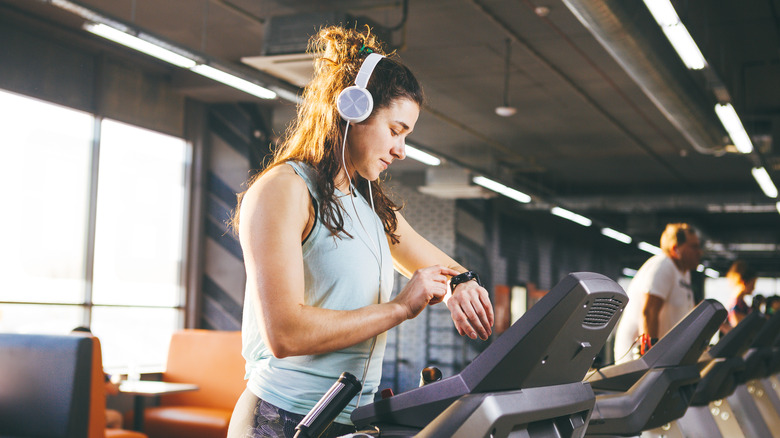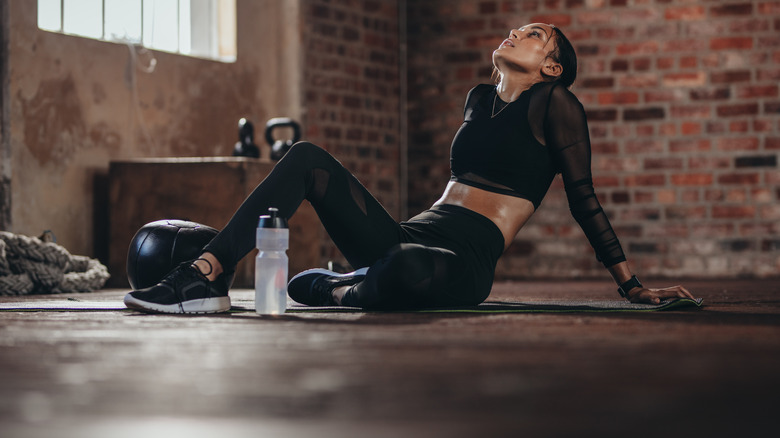The Truth About How And Why You Should Measure RPE At The Gym
Most gym-goers track their workouts in one way or another. Some use fitness watches or bands, while others rely on countdown timers. Another handy tool is the RPE scale, which allows you to measure training intensity. The acronym "RPE" stands for rated perceived exertion or rate of perceived effort. Athletes use this scale system to determine how hard they work in the gym or on the field.
The RPE scale runs from 0 to 10 or 1 to 10, depending on the rating system used. Generally, 0 or 1 is used to describe very light activities that require little or no effort, explains the Cleveland Clinic. Weight training is usually done at an RPE of 7 to 9. Anything above these values requires significantly more effort. Think about high-intensity interval training, sprinting, or long-distance running. Most athletes can barely breathe or speak when training at an RPE of 9 or 10.
A similar system is the Borg Rating of Perceived Exertion (RPE), also known as the Borg scale. This system is similar to the RPE scale described above, with the main difference being that it runs from 6 to 20, notes the Centers for Disease Control and Prevention (CDC). Both tools serve the same purpose, but the RPE scale is more user-friendly. Let's see how it works.
Why it makes sense to use the RPE scale
Some workouts feel harder and more intense than others. Just think about the dreaded leg day! Training intensity will also vary from one set to another, depending on the weight used. The RPE scale can help you determine how hard your body is working. This measure is subjective, but it can still be a good indicator of exercise intensity. You may use this system to optimize your workouts, break through plateaus, and prevent overtraining.
"RPE keeps you away from that fatigue point," competitive powerlifter Brandon Smitley told Muscle and Fitness. "The number one thing it teaches you is how to listen to your body," he added. Strength coach Pat Davidson, on the other hand, states that novice lifters don't really need to use the RPE scale: "Most new people lifting weights have no idea what it is to work at their maximum level" (via Muscle and Fitness).
However, there's nothing wrong with using RPE to tweak your exercise routine. If, say, your deadlifts normally feel like a 5 on the RPE scale, aim for a 6-7 RPE the next time you hit the gym. Or you can measure your RPE over several weeks to see how far you got. A workout that felt "extremely hard" (7-8 RPE) two months ago might feel "moderately hard" (6 RPE) today, meaning that you're making progress. Go ahead and play around with these numbers to set training goals, track your results, and adjust your weights.
How to measure RPE at the gym
The CDC recommends at least 150 minutes of moderate-intensity exercise or 75 minutes of vigorous exercise per week. You may also combine the two to keep your body guessing and prevent plateaus. In this instance, you can use the RPE scale to measure workout intensity. But if you're a weightlifter, then you can track your RPE for each set or exercise.
Sweat, a popular fitness app, recommends using this scale to determine how much weight you should lift. For example, if you feel like you could still complete a few extra reps at the end of a set, that's an RPE of 8 or lower. Generally, strength workouts performed at a 7-8 RPE are ideal for building mass. High-intensity resistance training, on the other hand, is performed at an RPE of 6 or 7. If you want to build strength rather than size, lift heavier and aim for an 8-9 RPE.
This rating system is suitable for aerobic workouts, too. Steady-state cardio is performed at an RPE of 3, so you should be able to easily hold a conversation during exercise. High-intensity interval training should be done at an RPE of 8 or higher. You can also use this tool to prevent and manage fatigue. If, say, your workouts feel harder than usual for several days in a row, you might be at risk for overtraining. In this case, aim for a lower RPE rating or take some time off.


